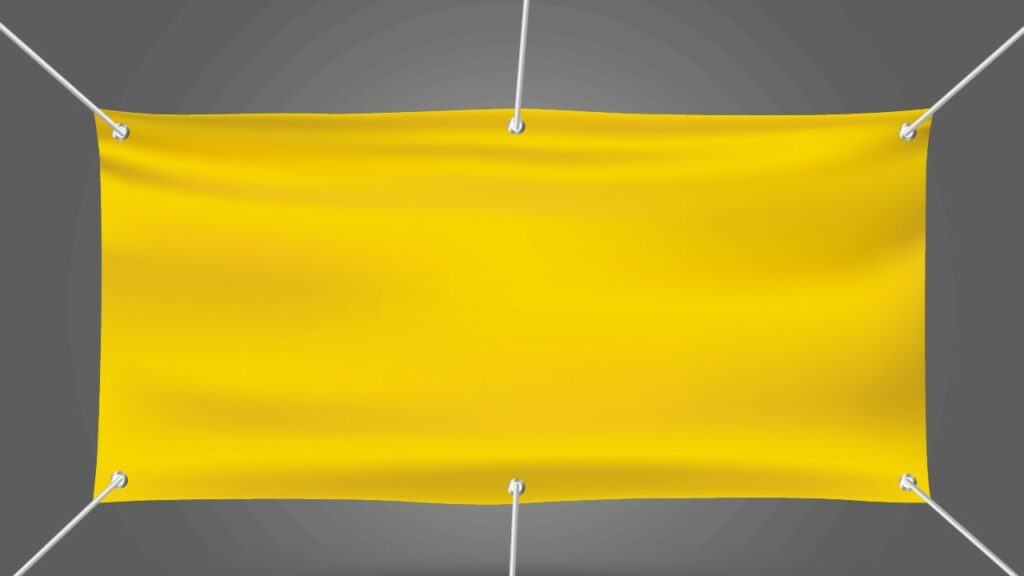There are numerous elements to consider when designing and printing a banner for your company (or a client). Even if you’re familiar with other sorts of print design (such as sticker or leaflet design), there are a few aspects of a great banner design that many designers neglect, and these are often vital to the banner’s success.
Banners, unlike many other printed marketing materials, must be easily seen and observed from a distance, which necessitates highlighting specific design aspects.
Positioning of the Banner
Before you make any other design decisions, you should think about where you want your banner to go. Although it may appear that we’re moving backwards, the color scheme (and even the entire design) that you use will most likely be influenced by the desired placement of your banner. Your banner’s color palette should, ideally, contrast sharply with its surroundings.
Make Large Text Work For You
One thing to remember about banners (as opposed to many other marketing materials like brochures and flyers) is that they are usually designed to attract attention from afar.
As a result, everything on your banner must be printed in large, readable type, as otherwise, your banner will be impossible to view from more than a few meters away.
Select a Typeface That Is Both Bold and Readable

It’s not just about the size of your text; you need also think about the typeface you’re employing and the weight of that font. There are many various typefaces to choose from, and it can be tempting to pick one that is really showy, but readability is always a factor when it comes to banners
Although bold sans-serif fonts are normally easier to read than serif fonts, this is not always the case. Even in newspapers, some serif fonts, such as Times New Roman, can be read readily. These Printroom banners are a great example of how it should be done.
Deliver A Simple Message
Another important factor to keep in mind when designing your banner is to keep the copy/message as simple as possible. In terms of text content, many successful banners are relatively simple, with most including no more than a few words.
The reason for this is simple: banners must transmit your message in the quickest time possible, because the majority of your target audience does not have time to read paragraphs of text (most are walking or driving by).
When creating your banner, be mindful of the copy that is and isn’t required. Remove anything that isn’t absolutely necessary, and make your statement as straightforward as feasible. Any information that is required should be included.
In the same way that you should delete everything unnecessary in your banner design, you should apply the same idea to the information in your banner design. Consider what you want to achieve with your banner when deciding what to include. Do you just wish to increase brand awareness?
Do you wish to inform visitors about a certain product, service, or characteristic of your business? Is there anything specific you’d like them to accomplish? If all you want your banner to accomplish is generate brand awareness, you may only need your company name and/or logo.
Remember to keep the aim in mind when producing your banner, and only include information that will help you achieve it. If your business address, for example, isn’t essential, don’t include it; it will clog the design.
Make Use of Images and Photos That are High-Resolution
Because the purpose of most huge vinyl banners is to attract attention (often from afar), you’ll want to do everything you can to get people to notice your banner. Color, typeface, and size have all been mentioned, but high-quality graphic images are also necessary.
Passers-by will tilt their attention in your direction if you use images as a focal point for your banner. High-quality images can help to not only draw attention to your message, but also to reinforce it and/or convey an emotion without the use of additional text. Remember to consider your brand.
Finally, while the techniques in this guide will help your banner stand out and attract attention in the end, you should keep your brand in mind throughout the design process. If a color clashes with your existing brand, don’t utilize it in your banner design just because it’s the most vibrant.
Colors Should be Tasteful

Colors have a wide range of associations, so consider what emotions you want to create in your audience. The colors must be spot on because they are the first thing people notice when viewing a large banner.
Colors can be subjective, and different cultures have different associations with them, so keep your target audience in mind when selecting colors. Following is a list of colors and the emotions they typically evoke in observers.
Red
The most powerful and appealing color to all audiences, as well as one thought to increase hunger. It’s best to use it sparingly.
- Love
- Speed
- Excitement
- Fury
- Passion
- Danger
Orange
It’s a great color for a call-to-action button because it’s lively, welcoming, and pleasant without being as overpowering as red.
- Happiness
- Health
Yellow
Touches of yellow can pique a viewer’s interest, and it’s even more energizing than orange and red. However, too much yellow can be irritating to the eyes because it reflects the most light of any color.
- Enthusiasm
- Optimism
- Brightness
- Wit
Green
This flower is associated with health, wealth, the environment, development, nurturing, and new beginnings. It’s the most attractive color to the eye.
- Nurturing
- Development
- Environment
- Wealth
- Health
Blue
- Coldness
- Refreshment
- Truth
- Elegance
- Formality
- Intellect
- Serenity
- Clarity
- Trust
- Safety
Purple
This gemstone has a relaxing and soothing influence on the audience.
- Creativity
- Feminity
- Ambition
- Magic
- Wisdom
- Extravagance
- Royalty
- Luxury
Pink
The color with the most feminine overtones.
- Infants
- Feminity
- Sweetness
- Love
Black
It’s classic, and the most readable color combination is black text on a white background.
- Formality
- Grief
- Prestige
- Power
- Mystery
- Wickedness
White
- Kindness
- Virginity
- Innocence
- Honesty
- Simplicity
- Sterility
- Modernism
- Cleanliness
- Purity
Brown
Stronger colors are balanced, and background colors and textures are enhanced.
- Humility
Gray
It amplifies other colors when used as a background.
- Neutrality
- Practicality
Do you need insurance coverage to your business? Check out our post on how to choose an insurance broker as well.
